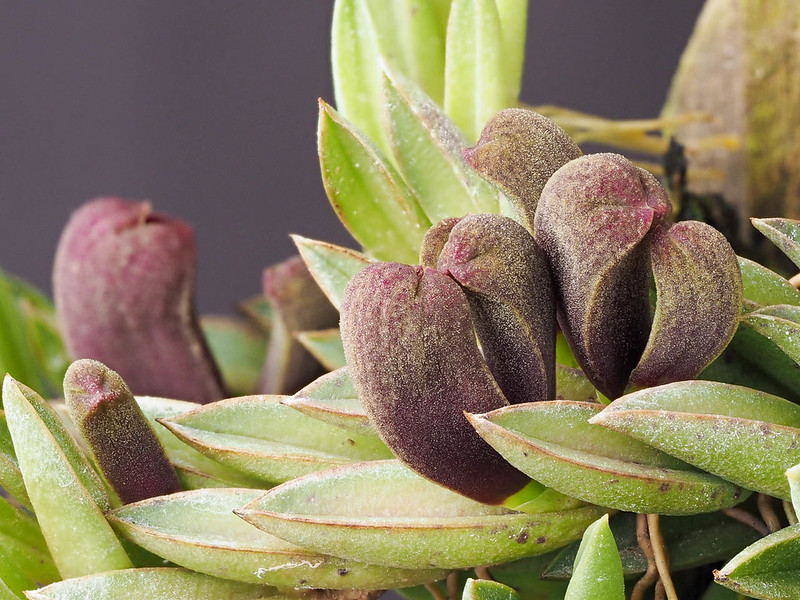
Happy Valentine's day! In the US, the dark side driven by hate and fear is strong at this moment, but it may be a good time to think about love. Since I'm not religious, I had to look up the origin of Valentine's day (link to wikipedia). St. Valentine was killed because of the difference in religious views more than 1700 years ago. It is pathetic that there are still primitive people who can't accept religious freedom (as seen in the recent events). Regardless of religion, nationality, or ethnic background, we all share the fundamental emotions such as love, joy, sadness, anger etc. Once we are blinded by the idea of right or wrong, the brain seems to focus on the differences rather than similarities within human (and animals). Many people can love people close to one another, but they cannot connect to people whom they do not know well or who do not share their values. This is obviously an evolutionarily adaptive response, but we can hope that we are not constrained by it.
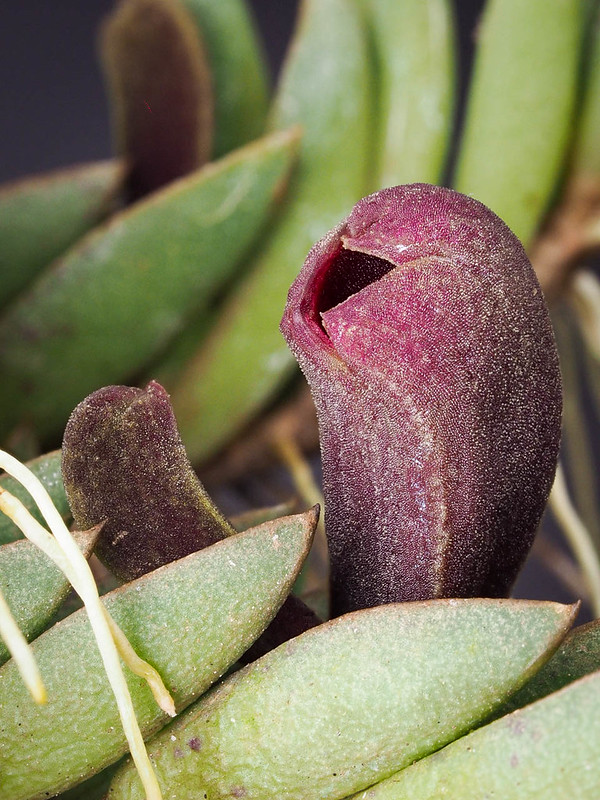 |
| Three sepals form a fused, sepaline tube. Note the shape of the opening hole, which is quite different from A. bragae. |
Genus affiliation of this species has been changed quite a bit in the past. Originally described as Physosiphon asaroides in 1907, some authors considered it to be in Phloeophila, Sarracenella, or Pleurothallis (link). Currently, it is in Acianthera, which is the 5th largest genus within subtribe Pleurothallidinae (Karremans 2016). There are at least 5114 recognized species in Pleurothallidinae, and Acianthera contains 116 recognized species (Karremans 2016).
According to IOSPE, both A. asaroides (link) and A. bragae (link) are from the south east Atlantic forest of Brazil. A. asaroides is endemic to Santa Catarina (de Siqueira et al. 2014), however, I didn't find any GBIF record (link). I couldn't find the elevation range for A. asaroides. A. bragae has GBIF records (link) from states of Esprito Santo and Santa Catarina. These 2 locations appear to be geographically separated, but this is possibly due to the low number of samples (13 records). Indeed, Parsons and Gerritsen (2013) stated a much wider distribution of A. bragae, from Minas Gerais, São Paulo, Rio de Janeiro, Paraná and Santa Catarina. The elevation range of A. bragae is 211-569m in GBIF records of Santa Catarina, but 700-1000m (Parsons and Gerritsen 2013) in Rio de Janeiro. de Siqueira et al. (2014) states that the habitat of these two species in Santa Catarina includes forest interior of tropical rain (ombrophilous) forests. Additionally, riparian forest was mentioned for A. bragae. So it appears that these two species are possibly sympatric in Santa Catarina, and they share similar habitat.
These two species appear to be frequently confused among hobbyists. There are several differences. The easiest difference is the shape of the opening at the end of sepals, which form a tubular structure (sepaline tube, which is the only part you can see in the flower). A. asaroides has a smaller opening (see the 2nd photo above) while A. bragae has the flared opening, with the three apices of sepals sticks out perpendicular to the axis of the sepaline tube, and it looks like kissing lips (vs "o" lips of A. asaroides). You can see this in the right most pair of flowers in the photo below. The flowers of A. asaroides is generally bigger than A. bragae. Finally, Parsons and Gerritsen 2013 mentioned that A. asaroides blooms in late winter to spring in cultivation while A. bragae blooms in summer to early autumn in nature. I do not know the blooming season of A. asaroides in nature, but the difference in the blooming time (phenology) may play a role to maintain these two possibly sympatric species apart.
 |
| Acianthera bragae (title: Sarracenella pubescens, which is an older synonym of A. bragae, by Dalton Holland Baptista 2003, licensed under Creative Commons Attribution-Share Alike 3.0 Unported |
I've been growing them in cool-end of intermediate temperature: max/min temperature of 86/65F in summer and 70/55F in winter. I've mounted it with minimum amount of sphagnum moss. So the roots dry out quickly, which is probably appropriate; I'm guessing this from the morphology of succulent, pencil-like leaves. They seem to grow ok with fairly weak light similar to or slightly more than the typical Phalaenopsis level (about 100-120 μmol m-2 s-1), but they are probably happier with stronger light.
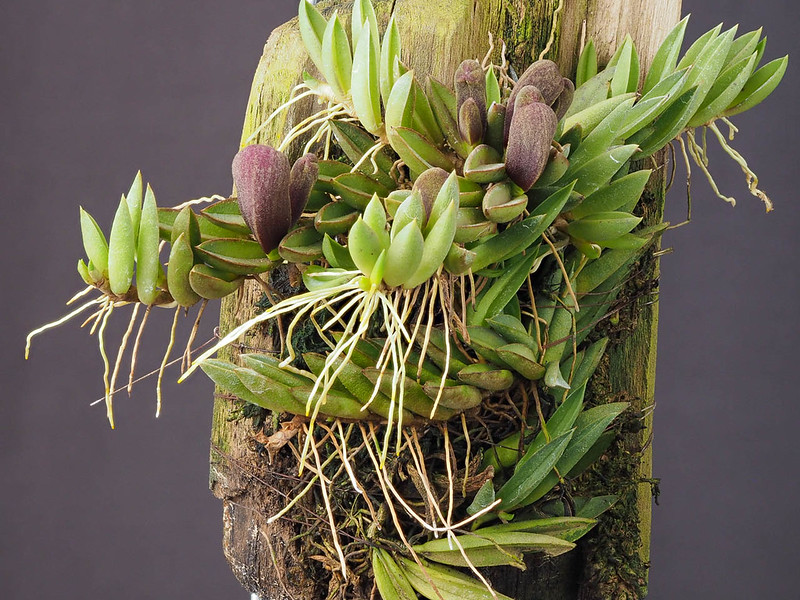
The purple/deep red structure is the calyx (sepals collectively), and the sepals are fused, and produce a tube like structure with a small opening at the end. Obviously, we are curious how the inside looks like. I split open the flower into a half. I didn't expect that inside is so hairy!
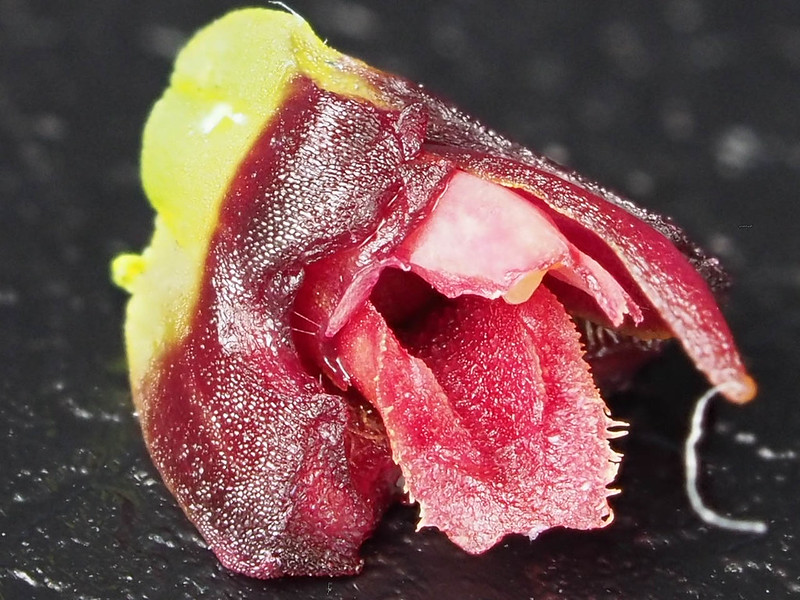 |
| Sepals are completely removed. The lip can be seen, and the column is the whitish structure on top of the lip. Right side petal is still attached. |
Literature Cited:
- de Siqueira, C. E., Zanin, A., & Neto, L. M. (2014). Orchidaceae in Santa Catarina: Update, geographic distribution and conservation. Check List, 10(6), 1452-1478. (link to PDF)
- Karremans, A. P. 2016. Genera Pleurothallidinarum: An updated phylogenetic overview of Pleurothallidinae. Lankesteriana 16(2): 219-241. (PDF)
- Parsons, R. and M. E. Gerritsen. 2013. A Compendium of Miniature Orchid Species Volume 1 (p. 102). Redfern Nautral History Productions, Poole, Dorset, England.
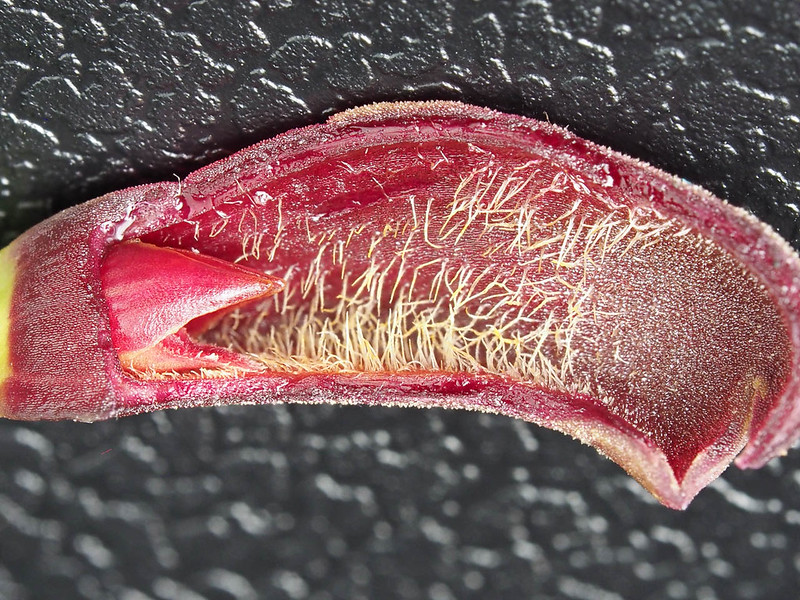
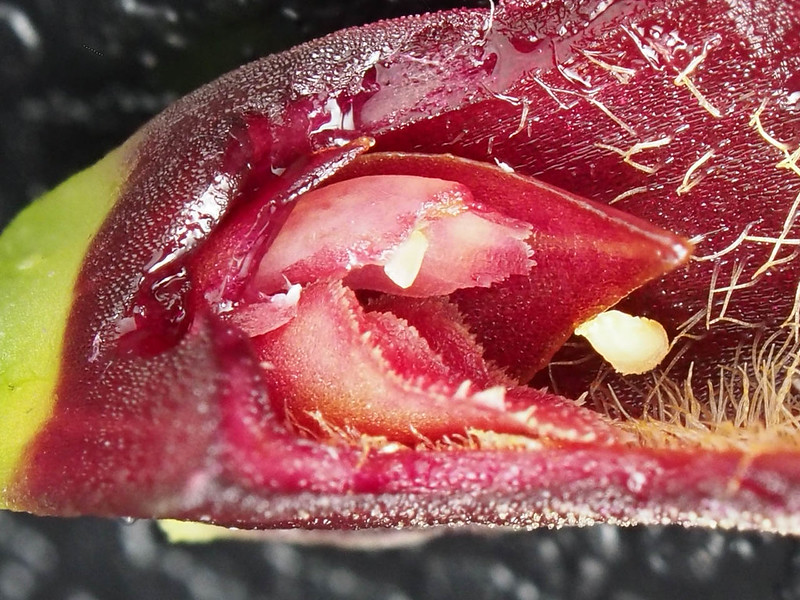
Awesome article - loved the dissected flower - I had no idea what they looked like inside.
ReplyDeleteThank you for the comment. Yes, lots of flowers, including orchid flowers, have cool structures and functions!
Delete